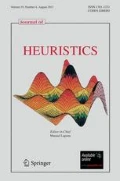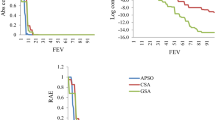Abstract
Heuristic optimization algorithms seek good feasible solutions to optimization problems in circumstances where the complexities of the problem or the limited time available for solution do not allow exact solution. Although worst case and probabilistic analysis of algorithms have produced insight on some classic models, most of the heuristics developed for large optimization problem must be evaluated empirically—by applying procedures to a collection of specific instances and comparing the observed solution quality and computational burden.
This paper focuses on the methodological issues that must be confronted by researchers undertaking such experimental evaluations of heuristics, including experimental design, sources of test instances, measures of algorithmic performance, analysis of results, and presentation in papers and talks. The questions are difficult, and there are no clear right answers. We seek only to highlight the main issues, present alternative ways of addressing them under different circumstances, and caution about pitfalls to avoid.
Similar content being viewed by others
References
Computational Testing of Algorithms.” INFORMS Journal on Computing 8, 318–330.
Arthur, J.L. and J.O. Frendewey. (1988). “Generating Travelling Salesman Problems with Known Optimal Tour Length.” Journal of the Operational Research Society 39, 153–159.
Baker, K.R. (1997). “Heuristic Procedures for Scheduling Job Families with Setups and Due Dates.” Working paper, Amos Tuck School of Business Administration, Dartmouth College.
Baker, K.R. and M.J. Magazine. (1997). “Minimizing Maximum Lateness with Job Families.” Working paper, Amos Tuck School of Business Administration, Dartmouth College.
Barr, R.S., B.L. Golden, J.P. Kelly, M.G.C. Resende, and W.R. Stewart. (1995). “Designing and Reporting on Computational Experiments with Heuristic Methods.” Journal of Heuristics 1, 9–32.
Barr, R.S. and B.L. Hickman. (1993). “Reporting Computational Experiments with Parallel Algorithms: Issues, Measures and Experts Opinions.” ORSA Journal on Computing 5, 2–18.
Bixby, B. and G. Reinelt. (1990). TSPLIB, Software Library, Rice University, Houston, Texas.
Boender, C.G.E., A.H.G. Rinnooy Kan, L. Stougie, and G.T. Timmer. (1982). “A Stochastic Method for Global Optimization.” Mathematical Programming 22, 125–140.
Burkard, R.E. and U. Fincke. (1983). “The Asymptotic Probabilistc Behaviour of Quadratic Sum Assignment Problems.” Z. Opns. Res. 27, 73–81.
Coffman, E.G., G.S. Lueker, and A.H.G. Rinnooy Kan. (1988). “Asymptotic Methods in the Probablistic Analysis of Sequencing and Packing Heuristics.” Management Science 34, 266–290.
Conover, W.J. (1980). Practical Nonparametric Statistics. New York: John Wiley.
Crawford, J.M. and L.D. Auton. (1983). “Experimental Results on the Crossover Point in Satisfiability Problems.” In Proceedings of the Eleventh National Conference on Artificial Intelligence AAAI93. pp. 21–27.
Crowder, H.P., R.S. Dembo, and J.M. Mulvey. (1979). “On Reporting Computational Experiments with Mathematical Software.” ACM Transactions on Mathematical Software 5, 193–203.
Dannenbring, D. (1977). “Estimating Optimal Solutions for Large Combinatorial Problems.” Management Science 23, 1273–1283.
Demirkol, E., S.V. Mehta, and R. Uzsoy. (1998). “Benchmarks for Shop Scheduling Problems.” European Journal of Operational Research 109, 137–141.
Derigs, U. (1985). “Using Confidence Limits for the Global Optimal in Combinatorial Optimization.” Operations Research 33, 1024–1049.
Fargher, H.E. and R.A. Smith. (1994). “Planning in a Flexible Semiconductor Manufacturing Environment.” In M. Zweben and M. Fox (eds.), Intelligent Scheduling. Morgan Kaufman.
Fisher, H. and G.L. Thompson. (1963). “Probabilistic Learning Combinations of Local Job-Shop Scheduling Rules.” In J.F. Muth and G.L. Thompson (eds.), Industrial Scheduling. New Jersey: Prentice-Hall, Englewood Cliffs.
Fisher, R. and L. Tippett. (1928). “Limiting Forms of the Frequency Distribution of the Largest or Smallest Member of a Sample.” Proceedings of the Cambridge Philosophical Society 24, 180–190.
Garey, M.R. and D.S. Johnson. (1979). Computers and Intractability: A Guide to the Theory of NP-Completeness. San Francisco: W. H. Freeman.
Garfinkel, R.S. and K.C. Gilbert. (1978). “The Bottleneck Traveling Salesman Problem: Algorithms and Probabilistic Analysis.” Journal of the ACM 25, 435–448.
Ghashghai, E. and R.L. Rardin. (1998). “Using a Hybrid of Exact and Genetic Algorithms to Design Survivable Networks.” Working paper, School of Industrial Engineering, Purdue University.
Golden, B.L. (1977). “A Statistical Approach to the TSP.” Networks 7, 209–225.
Golden, B.L. (1978). “Point Estimation of a Global Optimum for Large Combinatorial Problems.” Communications in Statistics B7, 361–367.
Golden, B.L. and F.B. Alt. (1979). “Interval Estimation of a Global Optimum for Large Combinatorial Problems.” Naval Research Logistics Quarterly 26, 69–77.
Golden, B.L., A.A. Assad, E.A. Wasil, and E. Baker. (1986). “Experimentation in Optimization.” European Journal of Operational Research 27, 1–16 (1986).
Golden, B.L. and W.R. Stewart. (1985). “Empirical Evaluation of Heuristics.” In E.L. Lawler, J.K. Lenstra, A.H.G. Rinnooy Kan, and D.B. Shmoys (eds.), The Traveling Salesman problem: A Guided Tour of Combinatorial Optimization. New York: John Wiley.
Goldsman, D. and B.L. Nelson. (1999). “Comparing Systems via Simulation.” In J. Banks (ed.), Handbook of Stimulation. New York: John Wiley.
Graham, R.L. (1969). “Bounds on Multiprocessor Timing Anomalies.” SIAM Journal of Applied Mathematics 17, 416–429.
Greenberg, H.J. (1990). “Computational Testing: Why, How and How Much.” ORSA Journal on Computing 2, 94–97.
Grötchel, M. and M.W. Padberg (1979). “On the Symmetric Traveling Salesman Problem I: Inequalities.” Mathematical Programming 16.
Grötchel, M. and M.W. Padberg. (1985). “Polyhedral Aspects of the Traveling Salesman Problem I: Theory.” In E.L. Lawler, J.K. Lenstra, A.H.G. Rinnooy Kan, and D.B. Shmoys (eds.), The Traveling Salesman problem: A Guided Tour of Combinatorial Optimization. New York: John Wiley.
Hall, N.G. and M. Posner. (1996). “Generating Experimental Data for Scheduling Problems.” Research report, College of Business, Ohio State University.
Hariri, A.M.A. and C.N. Potts. (1997). “Single Machine Scheduling with Batch Set-up Times to Minimize Maximum Lateness.” Annals of Operations Research 70, 75–92.
Hill, R.R. and C.H. Reilly. (1996a). “Multivariate Composite Distributions for Co-efficients in Synthetic Optimization Problems.” Research report, Department of Industrial, Welding and Systems Engineering, Ohio State University.
Hill, R.R. and C.H. Reilly. (1996b). “The Effects of Coefficient Correlation Structure in Two-Dimensional Knapsack Problems on Solution Procedure Performance.” Research report, Department of Industrial, Welding and Systems Engineering, Ohio State University.
Hooker, J. (1994). “Needed: An Empirical Science of Algorithms.” Operations Research 42, 201–212.
Hooker, J. (1995). “Testing Heuristics: We Have It All Wrong.” Journal of Heuristics 1, 33–42.
Jackson, R.H.F., P.T. Boggs, S.G. Nash, and S. Powell. (1991). “Guidelines for Reporting Results of Computational Experiments: Report of the Ad Hoc Committee.” Mathematical Programming 49, 413–425.
Jones, C.V. (1996). Visualization and Optimization. Boston: Kluwer Academic Publishers. Boston.
Karp, R.M. (1977). “Probabilistic Analysis of Partitioning Algorithms for the Traveling Salesman Problem in the Plane.” Mathematics of Operations Research 2, 209–224.
Khoury, B.N., P.M. Paradalos, and D.Z. Zhu. (1993). “A Test Problem Generator for the Steiner Problem in Graphs.” ACM Transactions on Mathematical Software 19, 509–522.
Kilbridge, M.D. and L. Wester. (1996). “A Heuristic Method of Assembly Line Balancing.” Journal of Industrial Engineering 12, 394–398.
King, J.R. (1980). “Machine-Component Grouping in Production Flow Analysis: An Approach Using a Rank Order Clustering Algorithm.” International Journal of Production Research 18, 213–232.
Klein, S. (1975). “Monte Carlo Estimation in Complex Optimization Problems.” Ph.D. Dissertation, George Washington University, Washington, D.C.
Krishnamurthy, B. (1987). “Constructing Test Cases for Partitioning Heuristics.” IEEE Transactions on Computing 36, 1112–1114.
Law, A.M. and W.D. Kelton. (1991). Simulation Design and Analysis, 2nd edn. New York: McGraw-Hill, Inc.
Lee, C.Y., J. Bard, M. Pinedo, and W.E. Wilhelm. (1993). “Guidelines for Reporting Computational Results in IIE Transactions.” IIE Transactions 25, 71–73.
Lenstra, J.K. (1977). “Sequencing by Enumerative Methods.” Mathematical Center Tract 69, Mathematisch Centrum, Amsterdam.
Lin, B.W. and R.L. Rardin. (1980). “Controlled Experimental Design for Statistical Comparison of Integer Programming Algorithms.” Management Science 25, 1258–1271.
Lin, S. and B.W. Kernighan. (1973). “An Effective Heuristic Method for the Travelling Salesman Problem.” Operations Research 21, 498–516.
Los, M. and C. Lardinois. (1982). “Combinatorial Programming, Satistical Optimization and the Optimal Transportation Network.” Transportation Research Board 16B, 89–124.
McGeoch, C.C. (1996). “Towards an Experimental Method for Algorithm Simulation.” INFORMS Journal on Computing 8, 1–15.
Mitchell, D., B. Selman, and H. Leveque. (1992). “Hard and Easy Distributions of SAT Problems.” In Proceedings of the Tenth National Conference on Artificial Intelligence AAA192. 459–465.
Monma, C. and C.N. Potts. (1989). “On the Complexity of Scheduling with Batch Setup Times.” Operations Research 37, 798–804.
Montgomery, D.C. (1991). Design and Analysis of Experiments, 3rd edn. New York: John Wiley.
Moscato, P. and M.G. Norman. (1998). “On the Performance of Heuristics on Finite and Infinite Fractal Instances of the Euclidean Traveling Salesman Problem.” INFORMS Journal on Computing 10, 121–132.
Ovacik, I.M., S. Rajagopalan, and R. Uzsoy. (2000). “Integrating Interval Estimates of Global Optima and Local Search Methods for Combinatorial Optimization Problems.” Journal of Heuristics, 6, 481–500.
Ovacik, I.M. and R. Uzsoy. (1997). Decomposition Methods for Complex Factory Scheduling Problems. Boston: Kluwer Academic Publishers.
Plicher, M.G. and R.L. Rardin. (1988). “Invariant Problem Statistics and Generated Data Validation: Symmetric Traveling Salesman Problems.” ONR-URI Computational Combinatorics Report CC-87-16, Purdue University, West Lafayette, Indiana.
Pilcher, M.G. and R.L. Rardin (1992). “Partial Polyhedral Description and Generation of Discrete Optimization Problems with Known Optima.” Naval Research Logistics 39, 839–858.
Pinedo, M. (1995). Scheduling: Theory, Algorithms and Systems. New York: Prentice-Hall.
Rardin, R.L. and B.W. Lin. (1982). “Test Problems for Computational Experiments-Issues and Techniques.” In M. Beckmann and H. P. Kunzi (eds.), Evaluating Mathematical Programming Techniques,Berlin: Springer-Verlag.
Rardin, R.L., C.A. Tovey, and M.G. Pilcher. (1993). “Analysis of a Random Cut Test Instance Generator for the TSP.” In P.M. Pardalos (ed.), Complexity in Numerical Optimization,World Scientific Publishing, pp. 387–405.
Sanchis, L.A. (1990). “On the Complexity ofTest Case Generation for NP-Hard Problems.” Information Processing Letters 36, 135–140.
Sanchis, L.A. (1994). “Test Case construction for the Vertex Cover Problem.” In Computational Support for Discrete Mathematics. DIMACS Series in Discrete Mathematics and Theoretical American Mathematical Society. Computer Science, Providence, Rhode Island: vol. 15.
Sanchis, L.A. (1995). “Generating Hard and Diverse Test Sets for NP-Hard Graph Problems.” Discrete Applied Mathematics 58, 35–66.
Song, W.T. and B.W. Schmeiser. (1994). “Reporting the Precision of Simulation Experiments.” In S. Morito, S. Sakasegawa, H. Yoneda, M. Fushimi, and K. Nakano (eds.), New Directions in Simulation for Manufacturing and Communications. pp. 402–407.
Tufte, E.R. (1983). The Visual Display of Quantitative Information. Cheshire, Connecticut: Graphics Press.
Tufte, E. R. (1990). Envisioning Information. Cheshire, Connecticut: Graphics Press.
Tukey, J.W. (1977). Exploratory Data Analysis. Reading, Massachusetts: Addison-Wesley.
Uzsoy, R., C.Y. Lee, and L.A. Martin-Vega. (1992). “Scheduling Semiconductor Test Operations: Minimizing Maximum Lateness and Number of Tardy Jobs on a Single Machine.” Naval Research Logistics 39, 369–388.
Wolff, R.S. and L. Yaeger. (1993). Visualization of Natural Phenomena. New York: Springer-Verlag.
Yoneda, K. (1996). “Optimal Number of Digits to Report.” Journal of the Operations Research Society of Japan 33, 428–434.
Zanakis, S.H. (1977). “Computational Experience with Some Nonlinear Optimization Algorithms for Deriving Maximum Likelihood Estimates for Three Parameter Weibull Distribution.” TIMS Studies in Management Science 7, 63–77.
Zanakis, S.H. (1979). “A Simulation Study of Some Simple Estimators of the Three-Parameter Weibull Distribution.” Journal of Statistical Computing and Simulation 9, 419–428.
Zanakis, S.H., J.R. Evans, and A.A. Vazacopoulos. (1989). “Heuristic Methods and Applications: A Categorized Survey.” European Journal of Operational Research 43, 88–110.
Zanakis, S.H. and N. Mann. (1982). “A Good Simple Percentile Estimator of the Weibull Shape Parameter for Use When All Three Parameters Are Unknown.” Naval Research Logistics Quarterly 29, 419–428.
Zemel, E. (1981). “Measuring the Quality of Approximate Solutions to Zero-One Programming Problems.” Mathematics of Operations Research 6, 319–332.
Author information
Authors and Affiliations
Rights and permissions
About this article
Cite this article
Rardin, R.L., Uzsoy, R. Experimental Evaluation of Heuristic Optimization Algorithms: A Tutorial. Journal of Heuristics 7, 261–304 (2001). https://doi.org/10.1023/A:1011319115230
Issue Date:
DOI: https://doi.org/10.1023/A:1011319115230




